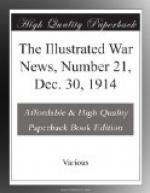_______________________________________________________
___________________ 46—THE ILLUSTRATED WAR NEWS, DEC. 30, 1914.—[Part 21]
[Illustration: A MISSING LONDONER! AN ENGLISH M.E.T. MOTOR-’BUS IN THE HANDS OF THE GERMANS AND PUT TO USE BY THEM.]
As with our London soldiers at the front, the fortune of war has levied its toll on other Londoners. Our photograph depicts the unfortunate fate that has befallen a once well-known object in the streets of London—one of the motor-’buses shipped across to France to serve in transporting British troops to the front, now in the hands of the enemy. Not many of them have had such bad luck, from all accounts, but accidents cannot be helped, and a victim has been claimed now and again, mostly at places where some raiding Uhlan patrol has managed to cut in and ambush one on some outlying road near the line of communications between the front and an army base, catching the ’bus while returning after discharging its soldier “fares.”
_______________________________________________________
___________________ THE ILLUSTRATED WAR NEWS, DEC. 30, 1914—[Part 21]—47
[Illustration: WEAPONS OF GREY “MOLES,” AT TSING-TAU: A LAND-MINE AND EMERGENCY HAND-GRENADES CAPTURED FROM THE GERMANS.]
The Germans made use of land-mines in the defence of Tsing-tau, and a few days after the town’s surrender, on Nov. 7, several exploded while they were being removed by the Japanese, causing much loss of life. It was stated that the explosions killed two officers and eight men, while one officer and fifty-six men were injured. The Germans also used hand-grenades, as shown in our photograph. These appear to have been of the improvised “jam-tin” type such as has been employed in the trenches in Flanders “Eye-Witness” wrote recently: “Mines have not played such an important part in this mole-work as might have been supposed. We have heard the enemy mining and we have tried it ourselves, but one strikes water in this country between seven and eight feet down.”—[Photo. by C.N.]
_______________________________________________________
___________________ 48—THE ILLUSTRATED WAR NEWS, DEC. 30, 1914.—[Part 21]
[Illustration: IN SHELTERS SUGGESTING A ROW OF MINIATURE RAILWAY-ARCHES! GERMANS IN THEIR “RABBIT-WARRENS” IN THE ARGONNE.]
“In the Argonne we beat back the enemy’s attacks and preserved our front.” That is a typical announcement one constantly sees in the Paris communiques recording events in the district where the photograph given above was taken. Special interest being taken in the fighting in Flanders, one rather overlooks the give-and-take warfare being carried on further east, where siege-trench fighting like that on the Aisne still goes on. There the Germans occupy deeply dug lines which are largely made up of underground galleries partly natural, partly artificial, in character, as our photograph shows. When the French artillery fire is severe, the Germans scuttle like rabbits into their burrows, coming out to man the trenches in front immediately the French infantry begin to approach.—[Photo. by C.N.]




